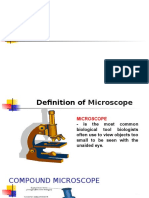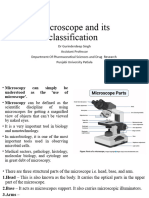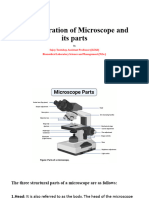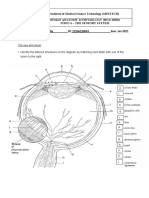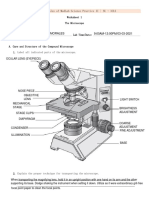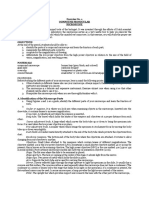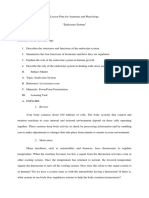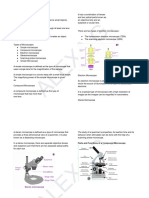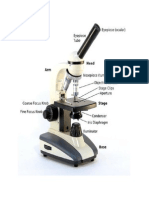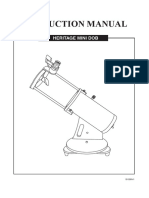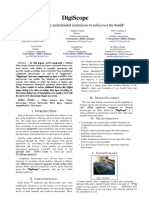Compound Microscope Parts
A high power or compound microscope achieves higher levels of magnification than a stereo or low
power microscope. It is used to view smaller specimens such as cell structures which cannot be
seen at lower levels of magnification. Essentially, a compound microscope consists of structural and
optical components. However, within these two basic systems, there are some essential
components that every microscopist should know and understand. These key microscope parts are
illustrated and explained below.
STRUCTURAL COMPONENTS
The three basic, structural components of a compound microscope are the head, base, and arm.
Head/Body houses the optical parts in the upper part of the microscope
Base of the microscope supports the microscope and houses the illuminator. Grab the arm
with one hand and place your other hand on the bottom of the base
Arm connects to the base and supports the microscope head. It is also used to carry the
microscope. Place one hand on the bottom of the microscope and use the back arm of the
microscope for carrying it.
When carrying a compound microscope always take care to lift it by both the arm and base,
simultaneously.
�OPTICAL COMPONENTS
There are two optical systems in a compound microscope: Eyepiece Lenses and Objective Lenses:
Eyepiece or Ocular is what you look through at the top of the microscope. Typically, standard
eyepieces have a magnifying power of 10x. Optional eyepieces of varying powers are available,
typically from 5x-30x.
Eyepiece Tube holds the eyepieces in place above the objective lens. Binocular microscope heads
typically incorporate a diopter adjustment ring that allows for the possible inconsistencies of our
eyesight in one or both eyes. The monocular (single eye usage) microscope does not need a
diopter. Binocular microscopes also swivel (Interpupillary Adjustment) to allow for different distances
between the eyes of different individuals.
Objective Lenses are the primary optical lenses on a microscope. They range from 4x-100x and
typically, include, three, four, or five on the lens on most microscopes. Objectives can be forward or
rear-facing. Never touch the lenses with your fingers. Your body produces oil that smudges the
glass. This oil can even etch the glass if left on too long. Use only LENS PAPER to clean the glass.
Nosepiece houses the objectives. The objectives are exposed and are mounted on a rotating turret
so that different objectives can be conveniently selected. Standard objectives include 4x, 10x, 40x,
and 100x although different power objectives are available.
Stage is where the specimen to be viewed is placed. A mechanical stage is used when working at
higher magnifications where delicate movements of the specimen slide are required. Stage
In the simplest case, the plain stage consists of a rectangular or square design containing several
clips to hold the specimen slide. It is where the specimen (usually mounted onto a glass slide) is
placed for observation. Stages are often equipped with a mechanical device that holds the specimen
slide in place and can smoothly translate the slide back and forth as well as from side to side.
• Function: The flat platform that supports the slides. The specimen is placed on the
stage for studying and examining the various features.
Fine adjustment knob
It is the smaller of the two knobs and is located further away from the arm of the microscope.
• Function: It is used to raise and lower the stage but more slowly and in a more
controlled manner under higher magnifications. It is used for sharp and fine focusing of the object.
For accurate and sharp focusing, this knob can be used.
Coarse adjustment knob
It is the bigger of the two knobs and is located closest to the arm of the microscope. It is a large
knob that is used for moving the body tube down and up.
• Function: It quickly gets the image in focus and bringing the object to be examined
under exact focus.
Stage Clips are used when there is no mechanical stage. The viewer is required to move the slide
manually to view different sections of the specimen. Stage clips hold the slides in place. The
mechanical stage of your microscope will help you to move the slide around by turning two knobs. One
knobs moves it left and right, the other knobs moves it up and down.
Aperture is the hole in the stage through which the base (transmitted) light reaches the stage.
�Illuminator is the light source for a microscope, typically located in the base of the microscope. Most
light microscopes use low voltage, halogen bulbs with continuous variable lighting control located
within the base.
Condenser is used to collect and focus the light from the illuminator on to the specimen. It is located
under the stage often in conjunction with an iris diaphragm.
Iris Diaphragm controls the amount of light reaching the specimen. It is located above the
condenser and below the stage. Most high-quality microscopes include an Abbe condenser with an
iris diaphragm. Combined, they control both the focus and quantity of light applied to the specimen.
Most laboratory microscopes have a rotating disk under the stage known as the diaphragm or iris.
Condenser Focus Knob moves the condenser up or down to control the lighting focus on the
specimen.
https://www.microscope.com/compound-microscope-parts
https://researchtweet.com/microscope-parts-labeled-diagram-and-functions/
https://www.cas.miamioh.edu/mbi-ws/microscopes/care.html










